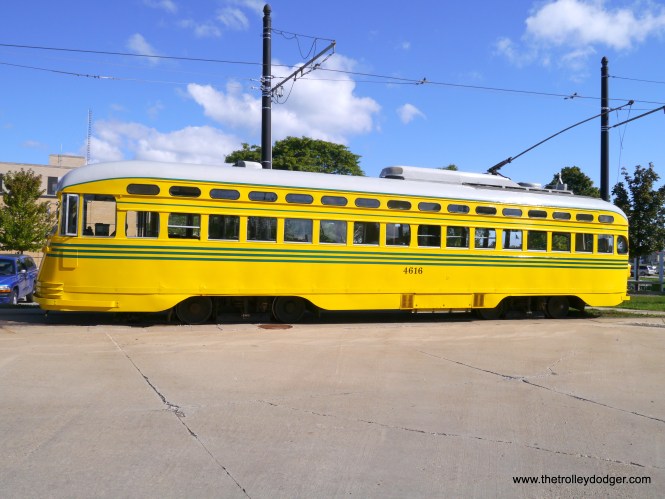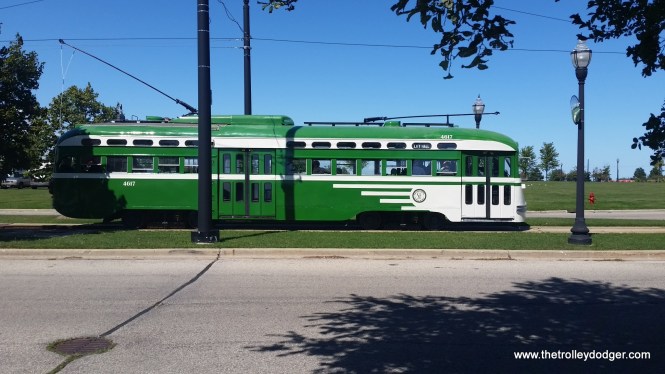Today’s post features more classic traction photographs by guest contributor Kenneth Gear. This is the third installment in a virtual career retrospective, covering 40 years of railfanning.
Ken has long been a friend of this blog. He has contributed greatly to our understanding of the Railroad Record Club of Hawkins, Wisconisn, and it is thanks largely to him that we have been able to share all 40 RRC LPs with you, digitally remastered on CDs and sounding better than ever.
We thank Ken for that, and for sharing these great images with our readers.
Click on these links to see Part 1 and Part 2 in this series.
-David Sadowski
Metra/ICG Highliners
Canadian National Box Cab

CN Box cabs 6710 & 6711 at Montreal photographed from the Amtrak MONTREALER approaching Central Station.
EX-NYNH&H 4400 “Washboard” MU
National Capitol Trolley Museum

Third Avenue Railway System car 678 still wears her bicentennial paint scheme as she sits outside the car barn at the National Capital Trolley Museum in May of 1989. The car has since been repainted in the TARS color scheme of red and white.
Electric City Trolley Museum
Pennsylvania Trolley Museum
Conrail

Conrail E-33 #4602 leads a long freight through the Metropark station at Iselin, NJ. 8-14-78. From my very first roll of color slide film.

Conrail E-44 #4430 leads a westbound train at the Metropark station, Iselin, NJ. From my very first roll of 35mm slide film.

Conrail sold E-44 #4464 to NJ Transit in 1983 for use as work train power. The locomotive never turned a wheel for NJT and it is shown here at the Ex-CNJ yard at Elizabethport, NJ. 5-25-83.

Conrail sold E-44 #4464 to NJ Transit in 1983 for use as work train power. The locomotive never turned a wheel for NJT and it is shown here at the Ex-CNJ yard at Elizabethport, NJ. 5-25-83.
Odds and Ends: Miscellaneous Traction:
New Orleans Streetcar
In 1982 I was in New Orleans, LA making an overnight connection between Amtrak’s CRESENT and the SUNSET LIMITED. In the general vicinity of the Amtrak station I took several photos of the streetcars. All of the streetcar photos were taken in the vicinity of Lee Circle.
All of these cars were built by Perley Thomas in 1924.
New York City Transit Authority
R-36

I wanted to include this photo in spite of the fact that the subject is Amtrak SSB-1200 #550 at Q Tower at Sunnyside, Queens, New York. I hope it will be of interest to traction fans because of the IRT subway train of NYCTA R-36 “Redbirds” passing overhead in the background. 6-20-87.
R-42
R-21

The NYCTA Car Repair yard at 207th Street in New York as seen from a boat in the Harlem River in 1986. Visible just behind the fence are two R-21 garbage motors. These cars were tasked with the removal of trash from the subway. The two shown here G7208 and G7206 have both been retired and most likely scrapped.

Apparently retired and not too far from being scrapped is R-21 #7086 at the 207th Street Car Repair yard.
R-38
R-32A

Starting in 1988 and continuing to 1990, NYCTA sent most of the R-32 cars to Morrison Knudsen at Hornell, NY for overhaul. Conrail brought the rebuilt cars loaded onto flat cars down the River Line to Greenville yard in Jersey City, New Jersey. From there the New York Cross Harbor Railroad car floated them back to New York City. On February 13, 1990 several of the rebuilt R-32a cars, including #3613 head out, were sitting in Greenville yard awaiting a boat ride home.

Starting in 1988 and continuing to 1990, NYCTA sent most of the R-32 cars to Morrison Knudsen at Hornell, NY for overhaul. Conrail brought the rebuilt cars loaded onto flat cars down the River Line to Greenville yard in Jersey City, New Jersey. From there the New York Cross Harbor Railroad car floated them back to New York City. On February 13, 1990 several of the rebuilt R-32a cars, including #3613 head out, were sitting in Greenville yard awaiting a boat ride home.

Starting in 1988 and continuing to 1990, NYCTA sent most of the R-32 cars to Morrison Knudsen at Hornell, NY for overhaul. Conrail brought the rebuilt cars loaded onto flat cars down the River Line to Greenville yard in Jersey City, New Jersey. From there the New York Cross Harbor Railroad car floated them back to New York City. On February 13, 1990 several of the rebuilt R-32a cars, including #3613 head out, were sitting in Greenville yard awaiting a boat ride home.

Eventually NYCHR Alco S-1s 25 & 22 came across the float bridge and coupled to the flat car containing the subway cars. The immaculate Alcos then loaded the car of R-32As onto the car float for a trip across the bay to Brooklyn.
Staten Island Rapid Transit Operating Authority:
R-44

Staten Island S-1 #821 & R-44 cars at Annadale. The Alco was leading an Electric Railroaders Association “Farewell to the Alcos” fan trip on October 25, 2008.

Staten Island Railway Alco S-2 #821 & S-1 #407 make way for an approaching train of R-44 cars at Tottenville, NY in October of 2008.
R-33 De-Icer
SEPTA – City Transit Division
PCC

SEPTA Kawasaki car #9023 & PCC #2129 at the Elmwood Avenue car barn in Philadelphia, PA in January of 1992.

SEPTA PCC car #2129 at 49th Street & Woodland Avenue in West Philadelphia PA. This car was built by the St Louis Car Company in 1948. It is now preserved by the Pikes Peak Historical Street Railway at Colorado Springs, CO.

PCC #2129 at the 80th & Eastwick loop in Philadelphia, which is the end of the Route 36. This photo was taken on January 25, 1992, the car was used on a Wilmington Chapter NRHS charter this day.

On May 7, 1995 Wilmington Chapter NRHS chartered SEPTA PCC #2799 in a Red Arrow paint scheme and PCC #2728 in the colors of the Philadelphia Transportation. The two brightly colored cars were posed side by side on Girard Avenue at 63rd Street in the Philadelphia neighborhood of Haddington.
Work Cars
Kawasaki Streetcar
AEM-7

SEPTA AEM-7 2307 in the yard at West Trenton NJ. It will soon power a fan trip excursion around the Philadelphia area. 3-29-92.

The Philadelphia Chapter NRHS arranged this over & under shot of SEPTA AEM-7 #2307 & P&W N-5 #451 at Norristown, PA on March 29, 1992.
SEPTA Regional Rail:
Blueliner

SEPTA Ex-Reading Blueliner MU train on a Philadelphia Chapter NRHS special during a photo stop at Glenside, PA on June 5,1988.

SEPTA Blueliner #9128 at Wissahickon, PA. Number 9128 has been preserved by the Reading Technical and Historical Society at Hamburg, PA. According to their website this MU, Reading Class EPb was built as an 80 seat steel coach by Harlan & Hollingsworth (subsidiary of Bethlehem Steel) in 1932 and converted into a MU trailer.

SEPTA Blueliners on a fan trip passing the Ex-PRR interlocking tower at Overbrook, PA on the famed Pennsy Mainline. 6-5-88.
Silverliners

A 3 car train of SEPTA Siverliners crossing the Delaware River at Morrisville, PA in January of 2010.

SEPTA Silverliner IV #368 on a R-5 train arriving at the Upper Level of 30th Street Station, Philadelphia PA. 4-25-93.
Chicago Trolleys

On the Cover: Car 1747 was built between 1885 and 1893 by the Chicago City Railway, which operated lines on the South Side starting in April 1859. This is a single-truck (one set of wheels) open electric car; most likely a cable car, retrofitted with a trolley and traction motor. The man at right is conductor William Stevely Atchison (1861-1921), and this image came from his granddaughter. (Courtesy of Debbie Becker.)
Check out our new book Chicago Trolleys. Signed copies are available through our Online Store.
This book makes an excellent gift and costs just $17.99 plus shipping. That’s $4.00 off the list price.
Help Support The Trolley Dodger
This is our 212th post, and we are gradually creating a body of work and an online resource for the benefit of all railfans, everywhere. To date, we have received over 408,000 page views, for which we are very grateful.
You can help us continue our original transit research by checking out the fine products in our Online Store.
As we have said before, “If you buy here, we will be here.”
We thank you for your support.
DONATIONS
In order to continue giving you the kinds of historic railroad images that you have come to expect from The Trolley Dodger, we need your help and support. It costs money to maintain this website, and to do the sort of historic research that is our specialty.
Your financial contributions help make this web site better, and are greatly appreciated.














































































































































































































